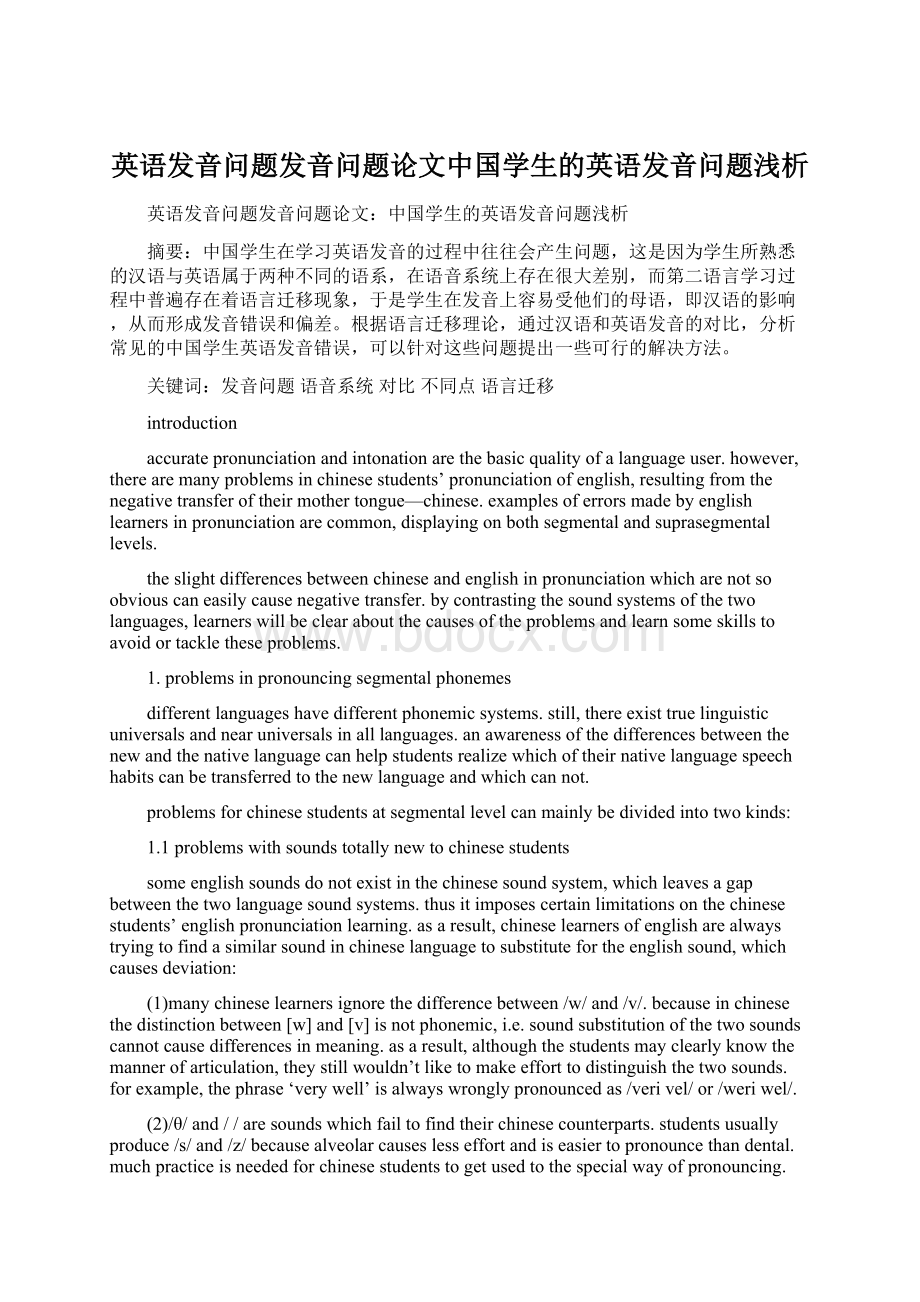英语发音问题发音问题论文中国学生的英语发音问题浅析Word文档格式.docx
《英语发音问题发音问题论文中国学生的英语发音问题浅析Word文档格式.docx》由会员分享,可在线阅读,更多相关《英语发音问题发音问题论文中国学生的英语发音问题浅析Word文档格式.docx(4页珍藏版)》请在冰豆网上搜索。

摘要:
中国学生在学习英语发音的过程中往往会产生问题,这是因为学生所熟悉的汉语与英语属于两种不同的语系,在语音系统上存在很大差别,而第二语言学习过程中普遍存在着语言迁移现象,于是学生在发音上容易受他们的母语,即汉语的影响,从而形成发音错误和偏差。
根据语言迁移理论,通过汉语和英语发音的对比,分析常见的中国学生英语发音错误,可以针对这些问题提出一些可行的解决方法。
关键词:
发音问题语音系统对比不同点语言迁移
introduction
accuratepronunciationandintonationarethebasicqualityofalanguageuser.however,therearemanyproblemsinchinesestudents’pronunciationofenglish,resultingfromthenegativetransferoftheirmothertongue—chinese.examplesoferrorsmadebyenglishlearnersinpronunciationarecommon,displayingonbothsegmentalandsuprasegmentallevels.
theslightdifferencesbetweenchineseandenglishinpronunciationwhicharenotsoobviouscaneasilycausenegativetransfer.bycontrastingthesoundsystemsofthetwolanguages,learnerswillbeclearaboutthecausesoftheproblemsandlearnsomeskillstoavoidortackletheseproblems.
1.problemsinpronouncingsegmentalphonemes
differentlanguageshavedifferentphonemicsystems.still,thereexisttruelinguisticuniversalsandnearuniversalsinalllanguages.anawarenessofthedifferencesbetweenthenewandthenativelanguagecanhelpstudentsrealizewhichoftheirnativelanguagespeechhabitscanbetransferredtothenewlanguageandwhichcannot.
problemsforchinesestudentsatsegmentallevelcanmainlybedividedintotwokinds:
1.1problemswithsoundstotallynewtochinesestudents
someenglishsoundsdonotexistinthechinesesoundsystem,whichleavesagapbetweenthetwolanguagesoundsystems.thusitimposescertainlimitationsonthechinesestudents’englishpronunciationlearning.asaresult,chineselearnersofenglisharealwaystryingtofindasimilarsoundinchineselanguagetosubstitutefortheenglishsound,whichcausesdeviation:
(1)manychineselearnersignorethedifferencebetween/w/and/v/.becauseinchinesethedistinctionbetween[w]and[v]isnotphonemic,i.e.soundsubstitutionofthetwosoundscannotcausedifferencesinmeaning.asaresult,althoughthestudentsmayclearlyknowthemannerofarticulation,theystillwouldn’tliketomakeefforttodistinguishthetwosounds.forexample,thephrase‘verywell’isalwayswronglypronouncedas/verivel/or/weriwel/.
(2)/θ/and//aresoundswhichfailtofindtheirchinesecounterparts.studentsusuallyproduce/s/and/z/becausealveolarcauseslesseffortandiseasiertopronouncethandental.muchpracticeisneededforchinesestudentstogetusedtothespecialwayofpronouncing.
(3)vowellengthdoesnotcausedifferencesinchinese.differenttonesareusedtodistinguishsoundsofthesamequality.forexample,mā,má
mǎ,mà
representfourdifferentwords.inchinese,sincetherearetones,themeaningsofwordscanbetoldeasily.althoughstudentsaretoldinenglishthereisdifferencebetweenshortvowelandlongvowel,theydon’tthoroughlyknowthewayofarticulation.inenglishtheshortvowelsdonotneedmuchmusculartension;
thetongueshouldbeheldloosely.inchinesetherearenosuchlaxandtensepairs,thustheybecomedifficultforchinesestudents.actuallyfewchinesestudentscanclearlydistinguishshortvowelsfromlongvowels.
(4)thereisno//inchinese;
studentsarenotusedtoopentheirmouthsowidely.theyoftenpronounce//wronglyas/e/or/ai/.forexample,it’shardtotellthedifferencebetweenbedandbadfromtheirpronunciation.
(5)thereisnophoneme//inchinese.manystudentspronounceitas/a/inchinesewithoutawarenessofit.chinesephoneme/a/isanopen,frontandunroundedlongvowelwithlipsspreadwhileenglish//isahalf-open,central,andunroundedshortvowel.forexample,whentheysaymother/m/,itoftensoundslike/ma/,andlikewise,love/lv/soundslike/lav/.
1.2problemswithsoundsconfusedbystudentsassomechinesesounds
englishandchinesephonesystemsdonotmatchcompletely.somephonemesseemtobesimilarbutfarfromidentical.yetthebeginninglearnersinevitablyresorttochinesesoundswhichhavesomesimilaritieswithenglishones.itisdifficultforthemtoutterwiththerightshapeofmouthortherightspeechorgan,especiallywhenthestudentstakeitforgrantedthattheyarethesamethings.
(1)althoughbothenglishandchinesehaveplosives,theirpronunciationsarenotexactlythesame.moststudentscan’theartheslightdifferenceinthestateofthevocalcords.inenglish,plosivesgoincontrastivepairs,withonevoicedandtheothervoiceless.butchineseplosivepairsaredistinguishedfromeachotherbyaspiration,notbyvoicing.forinstance,inchineseboth“b”and“p”arevoiceless.soaretheotherpairssuchas“d”and“t”;
“g”and“k”;
“zh”and“ch”,etc.theonlydifferenceisthat,inpronouncingtheaspirated“p,t,k,ch”,theairispuffedoutstrongly,whereaswiththeunaspirated“b,d,g,zh”theairislet